The desert rain frogs thrive in a climate where it is almost impossible for other amphibians to survive due to the scorching temperature and arid climate. But the creature defines all odds and finds the hot sands as its sweet home.
The origin of this species was traced almost 370 million years ago in the eastern part of Greenland. The ancestors of the amphibians are also called “The first four-legged fish”.
In this article, we will delve into the world of desert rain frogs where we will explore some unknown facts such as their characteristics, and adaptation techniques and if it is a good pet or not, which you probably never heard of. Get started.
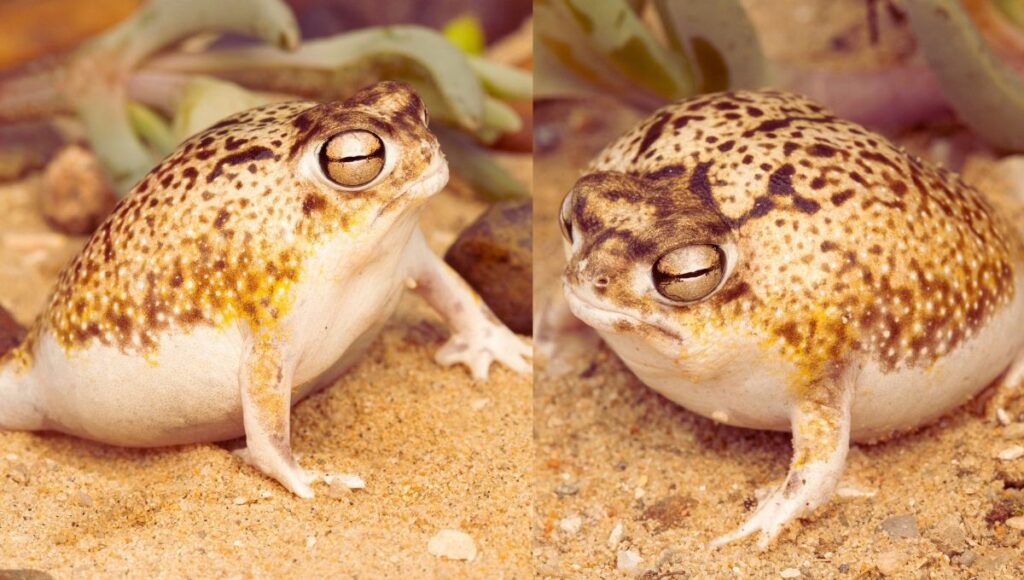
Table of Contents
Desert Rain Frog- In a Glimpse:
| Common Name: | Desert Rain Frog |
| Scientific Name: | Breviceps macrops |
| Other Names: | Boulenger’s short-headed frog and web-footed rain frog |
| Group Name: | Army, colony |
| Adult Length: | 4-6 cms |
| Adult Weight: | 11-14 grams |
| Colour: | Yellowish-Brown |
| Skin Type: | Transparent |
| Distribution: | Namibia and South Africa |
| Habitat: | sand dunes |
| Characteristics: | nocturnal |
| Lives in: | burrows usually in moist soil and 10-20 cm deep |
| Vocal Sound: | high-pitch squeak during mating season. |
| Breeding Season: | June-October |
| Litter Size: | 12-40 |
| Distinctive Feature: | inner parts of the body can be seen, high-pitch squeak during mating season, turns to adult directly from eggs, cannot jump due to stout body with small legs etc. |
| Diets: | Moths, beetles, insects larvae |
| Predators: | Eagles, Honey Badgers, Snakes, Antelopes etc |
| Life Span: | 3-5 years but in captivity up to 15 years |
| Speed: | 10 km/h |
| Threats: | opencast diamond mining, road construction, increasing human settlement and hunting. |
| IUCN Status: | Near Threatened |
| Can be a pet? | Yes |
10 Fascinating Facts About Desert Rain Frogs:
Scientific Classification:
| Domain: | Eukaryota |
| Kingdom: | Animalia |
| Phylum: | Chordata |
| Class: | Amphibia |
| Order: | Anura |
| Family: | Brevicipitidae |
| Genus: | Breviceps |
| Species: | Breviceps macrops |
Physical Description:
The desert rain frog has a rounded shape body with swelling eyes, a short snout, short limbs, spade-like feet, and webbed toes. One can see the interior parts of the body as the underside skin is very transparent.
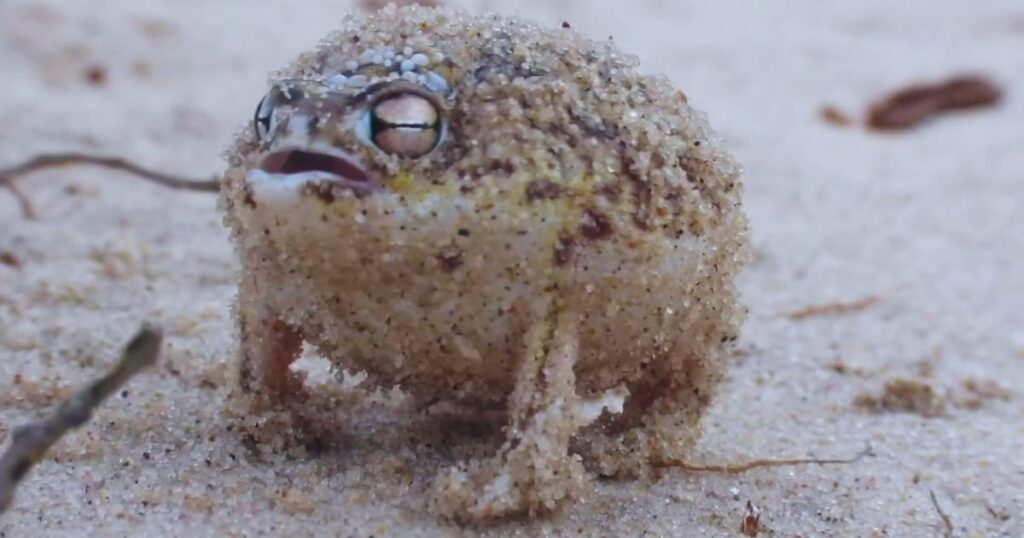
The adult rain frogs can be 4-6 cm or 1.5-2.5 inches in length and weigh around 11-14 grams. The skin colour is yellowish-brown or caramel colour as the sand sticks to their body.
One of the most fascinating facts is that, unlike other frogs, this frog species turns to adult directly from eggs without surviving their tadpole stage. Desert rain frog has bulky figures with small legs and webbed feet that are not suitable for hopping and leaping, thus they mostly walk on the sand. Another distinct feature of this frog is unlike other frog species, the desert frog doesn’t need water to survive.
Distribution and Habitats:

Unfortunately, the distribution of the beautiful species is only limited to the land 10 km wide along the coast of Namibia and South Africa. This area is known for arid dunes with very little rainfall.
The habitat of the frog is an example of xerophytic vegetation which is adapted to live in arid conditions. It is accustomed to living in water-scarce regions.
How does the desert rain frog survive without water?
As a part of xerophytic vegetation, the frog species are adapted to live without water by burrowing underground and waiting for dry periods. They can absorb water with their transparent skins. The fog plays an important role in their lifestyle as it supplies essential moisture for their lives.
Also Read: Are Pixie Frogs (African Bullfrogs) Good Pets? Everything You Should Know Before Purchasing
Behaviour:
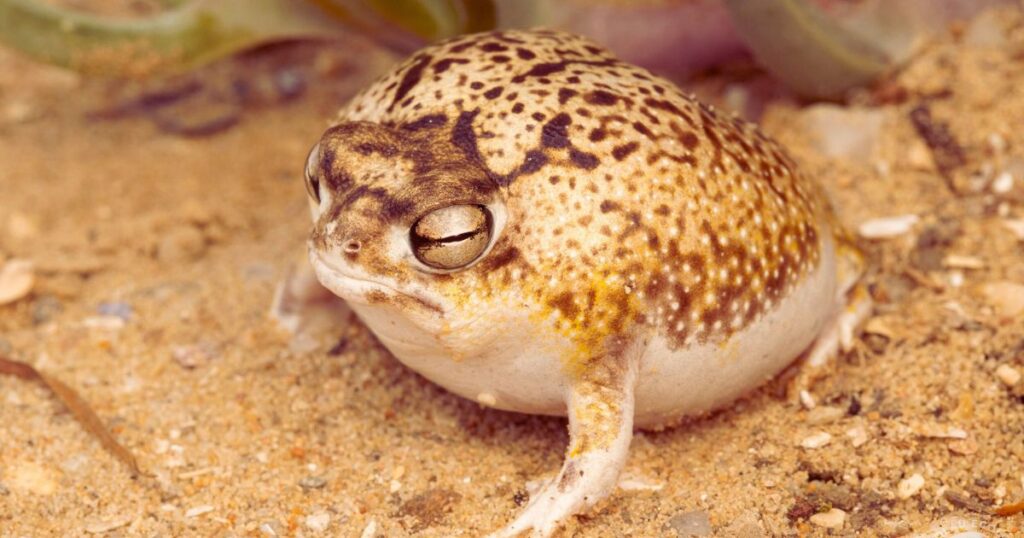
The rain frogs are nocturnal. The frog species loves to spend the day inside a burrow which is 10-20 cm deep and dug into moist soil. It often comes out from burrows at night and roams around the sandy dunes.
The footprints are another distinctive feature. The footprints are often found around patches of dung which are assumed to consume the smaller insects. The frog usually digs the burrow in the morning and its presence can be understood by a little heap of sand.
Are Desert Rain Frogs Poisonous?
No, these frogs are not poisonous at all. They often call out with a fearsome roar whenever they are threatened as a part of their defence mechanism. The frog’s bite is about on par with its bark.
Vocalization:
Despite their tiny size, desert rain frogs are known for their loud high-pitched squeak which is also popular as their war cry. The sound is similar to that of angry dogs chewing toys. Thus the frog is also nicknamed as “angry rain frog”. The cry is produced only in mating season or when it is threatened.
Also Read: Are Cape Rain Frogs Good Pets? 8 Fascinating Facts
Moisture Conservation:
As the desert rain frog lives in dry climatic regions, their transparent skin contains specialized glands that can hold moisture and stay hydrated during draughts. As the rainfall is very low (around 50 mm), fog supplies the essential moisture to the frog. The other sources of moisture are food, small insects and little rainfall.
Reproduction and Breeding:
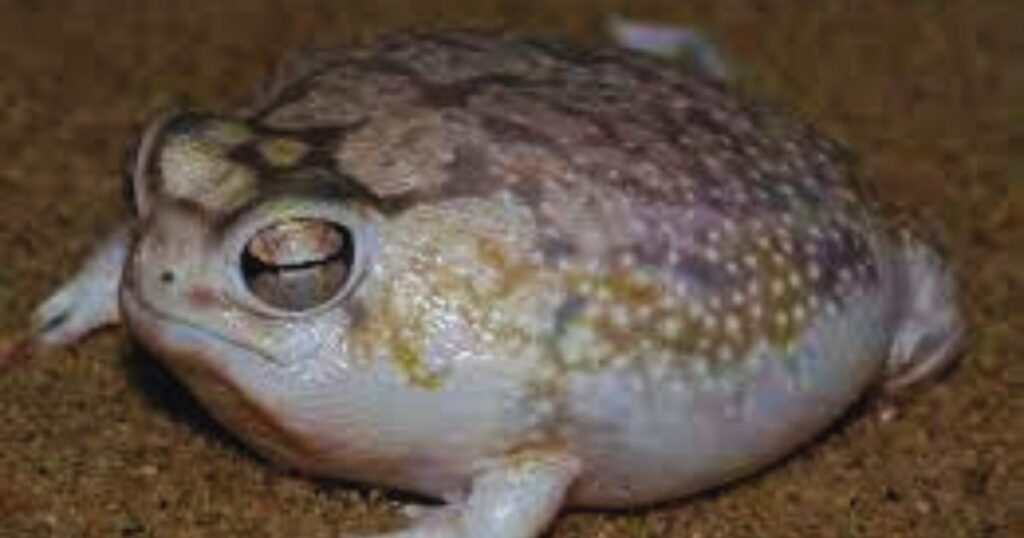
The breeding season usually occurs between June and October. On a foggy night, the male frog comes out from the burrow and calls out the female partner using a distinctive squeaking sound.
If a willing female approaches the male for mating, they go underground and after mating the female lays a clutch of eggs which is around 12-40 eggs. The eggs hatch into froglets but it doesn’t go through a tadpole stage like other frog species. The froglets turn fully adult from the eggs and can move and hunt small insects on their own.
Life Span:
The desert rain frogs usually live up to 3-5 years. But in captivity, they can live up to 15 years.
Diets:
The desert rain frogs are insectivorous. Being nocturnal, rain frogs hunt at night and feed on small insects larvae, moths and beetles. Cannibalism is not known to this species.
Predators:
The Cape eagle owl, the majestic black eagle, the Cinnamon-breasted warbler, the honey badger, antelopes, snakes, scorpions and rodents are the main predators of the desert rain frog.
Speed:
Rain frogs cannot hop but they can walk fast up to 10 Kmph. This speed helps them to evade predators as well as hunt insects.
Threats:
The frog species face a lot of anthropogenic threats which may lead to their extinction from the wild. Over the years, the habitat and the population of the frog species have been squeezed due to opencast diamond mining, road construction and increasing human settlement in the region.
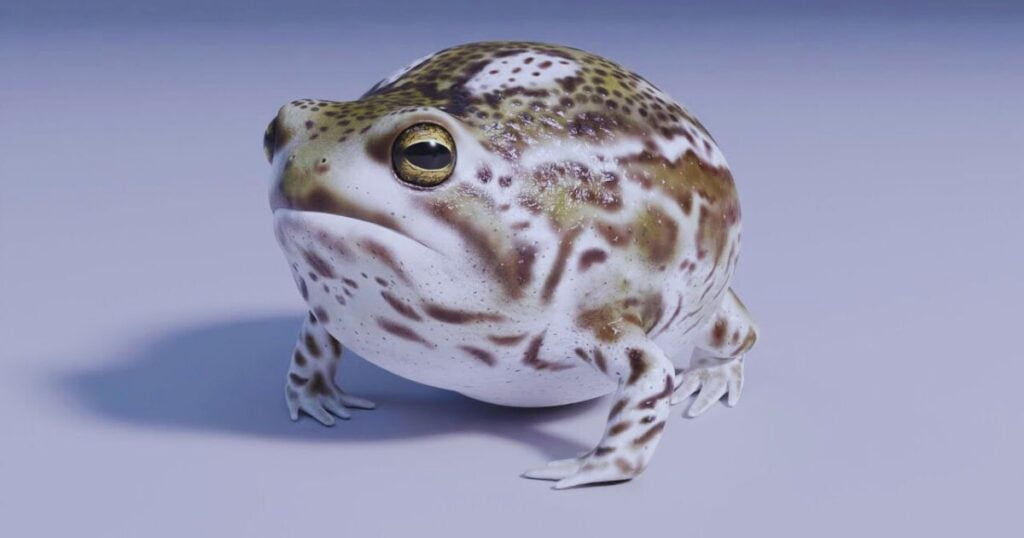
Currently, the habitat range of Desert rain frogs is less than 2000 sq. km and is also fragmented. Previously the number of individual frogs was decreasing but recently the number is unclear.
South Africa has banned opencast mining in the region to restore the population of the frog but no evidence of their restoration has been found so far.
Desert frogs are also part of the delicacy in some tribal cultures. Rain frogs are also hunted for their meat. However, some countries around the world like the United States of America have imposed a ban on the import of the frog species.
Conservation Status:
The desert rain frogs are listed as “Near Threatened” in the IUCN Red List of Threatened Species. However, the frog species is not listed in CITES.
Is Desert Rain Frog a Good Pet or Not?
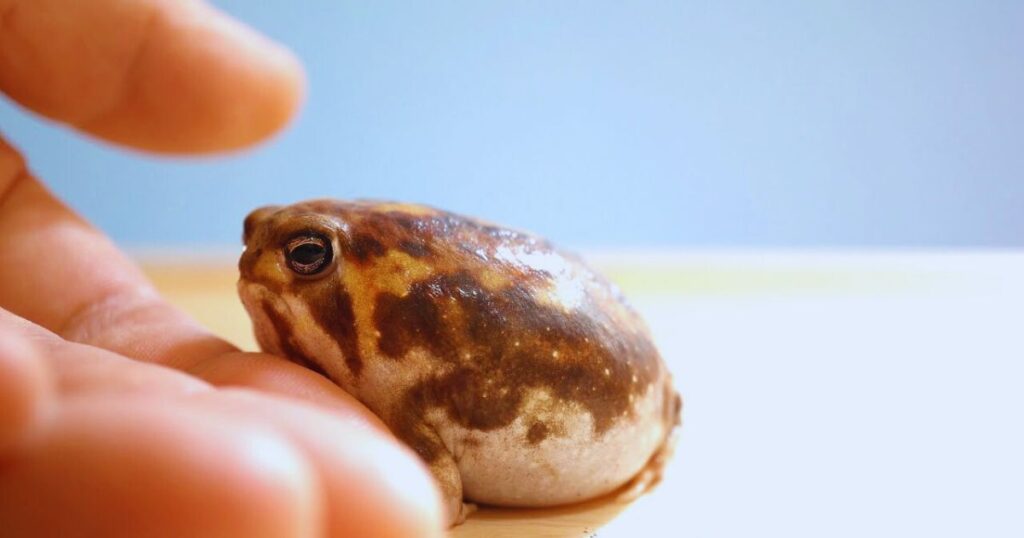
Rain frogs are neither dangerous nor poisonous to humans or other animals. You may only have this species as your pet if it is legal in your country.
Before you make them your pet, keep in mind that you need to provide them with enough space to dig and make their burrow. Regulate the temperature, and humidity and feed them well- these are some basic requirements.
However, you cannot expect enough affection from your pet frog as it has no emotional bond with you. They are peaceful with you only when you feed them well. Your existence will be only a food supplier to the frog.
Hence, you can keep a desert rain frog as a pet because they are neither poisonous nor causes much trouble to the owner. They are low-maintenance frogs and it is easy to take care of them once you set up their habitat. These rain frogs don’t have any special requirements regarding their survival or feeding. You need to ensure that the desert rain frogs feel safe, secure, and healthy to live longer because a stressed frog can’t survive for a long time.
How to Buy and What is the Price of a Desert Rain Frog?
Desert Rain frogs are not very common domestic pets in the Western world but it is also not impossible to find. You can visit your nearby pet shop and order a desert rain frog or depending on your location you can order them online. There are multiple websites available that allow you to buy frogs in any part of the world with the help of only a few clicks.
The price of these frogs depends on the availability of these frogs. However, in the USA the frog will cost around $45-$150 depending on your location and the availability of the frog. Whereas, in the UK or other European countries it’ll cost around £50- £120.
Requirements and Care:
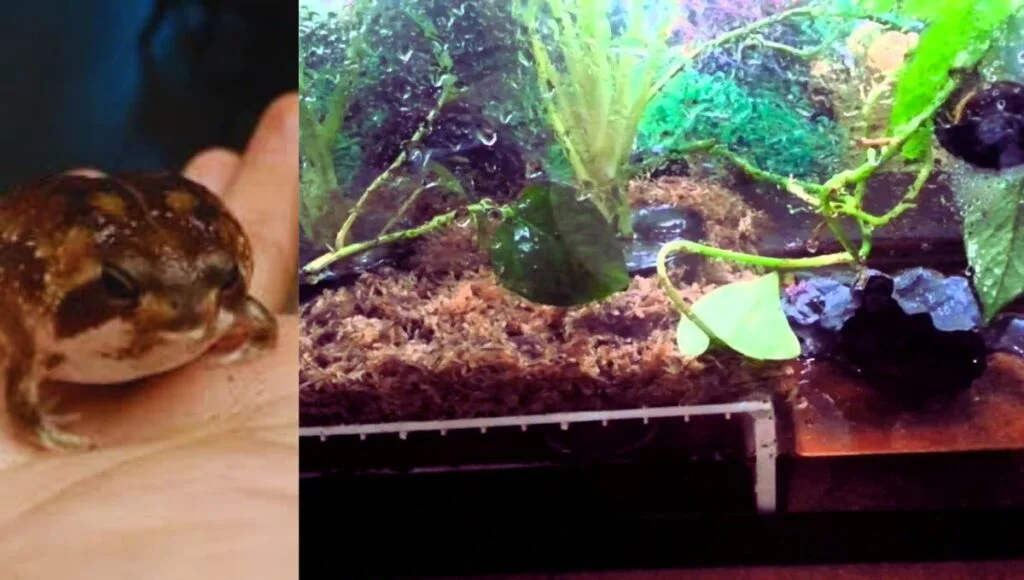
Tanks and Substrate:
The bigger the tank, the better for the frogs. It is advisable to have at least 10-gallon tanks with a secure lid and ventilation holes. The substrate should be at least 4 inches deep and made up of moist sand or a mixture of sand and coconut fibre.
There should be some hiding place for the desert rain frogs such as cork bark, driftwood, or artificial plants. You will also need a shallow dish in which the frog drinks, and baths and the dish should be cleaned daily.
Our Recommendations:
Tanks:
We suggest you buy a Zilla 10 Gallon Pet Reptile Starter Habitat for your desert rain frog. It has a transparent view, secure lid, and perfect ventilation system and also includes One 5.5″ reflective dome light fixture, white spot bulb, small heat mat, green terrarium liner, and humidity/temperature gauge. Most importantly, it is big and safe enough for your frog.
Buy NowDecorations:
Decoration inside the enclosure and having some live or artificial plants are important for the frogs. You can buy PINVNBY Resin Reptile Platform Artificial Tree Trunk which is made up of premium resin, eco-friendly, non-toxic, pollution-free, and completely safe.
Buy NowSubstrate:
Natural substrates are best but if you are unable to find them we suggest you buy Josh’s Frogs BioBedding Tropical Bioactive Substrate which is eco-friendly, clean, attractive, natural, perfect to plant live plants, and the frogs can burrow easily.
Buy NowTemperature and Humidity:
As the name suggests, the frogs need warm and humid weather to thrive. In the daytime, the frogs need 75-85 degrees Fahrenheit temperature and at night the temperature requirement is a bit less (60-70 degrees Fahrenheit).
The frogs also need a dry environment and hence the humidity level should be adjusted between 45% and 60%. You can use a heat lamp or heat mat to increase the temperature of the enclosure during winter but prevent the enclosure from overheating too.
Feeding:
Desert rain frogs are primarily insectivorous. The frogs usually consume various insects such as crickets, earthworms, mealworms, and waxworms. The insects should be loaded and dusted with calcium and vitamin supplements before feeding.
How much food a rain frog eats completely depends on its sex, size, health condition, and appetite. The frogs should be fed every other day and uneaten food should be removed from the tank daily to prevent mold and bacteria growth.
Cleaning:
The tank should be cleaned and remove waste food, dead insects, and bacterial substances regularly to prevent bacteria growth and make the environment healthy for the frogs.
The entire enclosure should be deep-cleaned every month with a mild disinfectant and the substrate should be changed every 10-12 weeks. If the substrate becomes dirty or smelly then you need to change it more often.
Our Recommendations:
Fogger:
You don’t need a fogger if you can sprinkle water in the tank several times a day, but if you are unable to do so then we suggest Reptile Fogger Terrariums Humidifier Fog Machine, which is large, signals when the tank is dry, adjustable, and highly efficient with a 1-year warranty.
Buy NowDisinfectant:
You can use any mild disinfectant to clean the tank which is non-toxic to desert rain frogs. We suggest Premium Oxyfresh Terrarium Cleaner because it is easy to use (just spray and rinse away), safe, eco-friendly, non-toxic, odour eliminator, and Leaping Bunny Certified.
Buy NowYour tiny desert rain frog can live up to 15 years with proper nutrition and care if you are aware of them. Following the above instructions, you can maintain their health so they can live longer.
Frequently Asked Questions (FAQs):
What size tank does a desert rain frog need?
Rain frogs don’t need an open water source. A 10-gallon or 38-litre tank is required for every frog.
How does a desert rain frog survive?
The frog species can survive without water. They spend their daytime inside burrows which are dug in moist soil. They receive moisture from the fog, foods and small insects. The skin is also able to absorb moisture from nature.
Are desert rain frogs rare?
Yes, they are rare. Now the species is restricted only to the coastlines of Namibia and South Africa. Their habitat range is even smaller than 2000 sq km. The population of the species is unknown.
Why do desert rain frogs squeak?
The frog often emits a high-pitched squeaking sound and it sounds like an angry dog chew toy. They usually use the sound in the breeding season to call out their female partners and when they are threatened.
Are desert rain frogs a good pet?
The frogs are not poisonous to any human or animal. If the law of your country allows, then you may have it as a pet. You just need to provide them with enough space to dig their burrow, proper temperature, humidity and food. But you cannot expect much affection from your pet.
What does a desert rain frog eat?
The frog species usually consume moths, beetles and insect larvae. The food supplies them with moisture to survive without water.
Do rainfrogs jump?
Unlike other frog species, desert rain frogs are very unsuitable for jumping. The stout body with small legs doesn’t allow them to jump like other frogs but they can walk on the sand at a speed of 10 km/h.
How long do desert rain frogs live?
The lifespan of the frog usually is 3-5 years. But in captivity, the species can live up to 15 years.
The Desert rain frogs define all the odds by thriving in one of the harshest climates in the world. Still, it doesn’t get enough attention and appreciation from animal lovers. If proper steps are not taken to conserve the cute frog species, probably in a few decades the desert rain frogs will be completely extinct from the wild.
References: Desert rain frog on Wikipedia
Also Read: Mountain Chicken: Is Giant Ditch Frog in Danger?
Also Read: Smoky Jungle Frog: Everything About the Frog in Only 2 Minutes